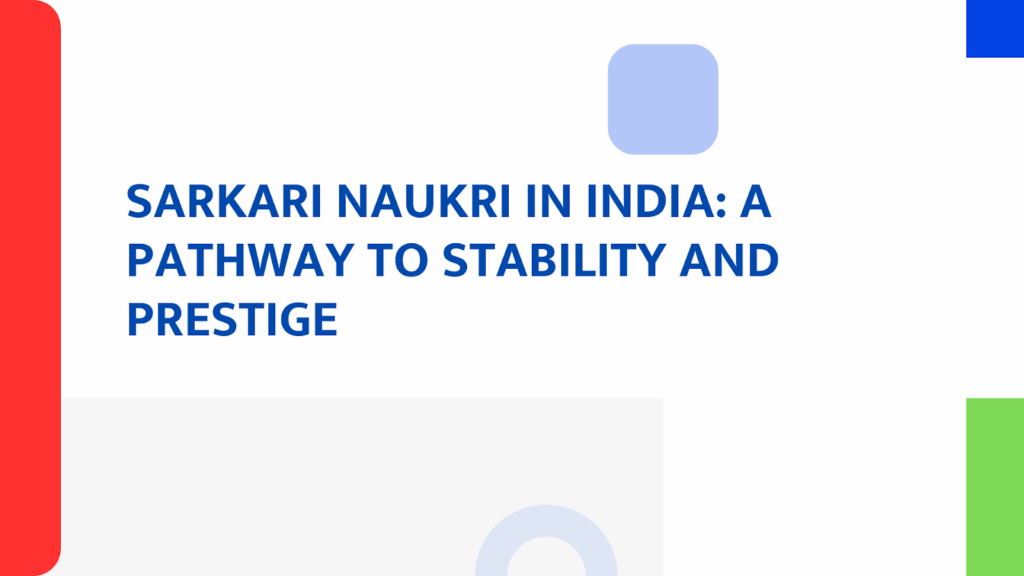Sarkari Naukri, or government jobs in India, remain a coveted career choice for millions, offering unmatched stability, benefits, and social respect. With intense competition and a rigorous selection process, these jobs are both a dream and a challenge. This article explores the significance, categories, recruitment, challenges, and future trends of Sarkari Naukri, reflecting its pivotal role in India’s employment landscape.
Why Sarkari Naukri Attracts Millions
The primary allure of government jobs is job security, a rare feature in the private sector, where economic uncertainties often lead to layoffs. Government employees benefit from fixed salaries, periodic increments, and retirement schemes like the National Pension System (NPS) or, for some, the Old Pension Scheme (OPS).
Perks such as medical insurance, housing benefits, and generous leave policies ensure financial and personal stability. In 2024, over 15 lakh candidates applied for 10,000 SSC CGL posts, highlighting the demand.
Socially, Sarkari Naukri commands prestige. Positions like Indian Administrative Service (IAS), Indian Police Service (IPS), or even junior roles in government offices elevate one’s status in society. For rural families, where private-sector jobs are scarce, a government job signifies success and security, making it a cultural aspiration.
Categories of Government Jobs
Sarkari Naukri spans diverse sectors, accommodating various qualifications:
- Central Government: Elite roles like IAS, IPS, and IFS, recruited via UPSC, alongside jobs in railways, defense, and PSUs like BHEL or NTPC, offering high pay and mobility.
- State Government: State administrative services, teaching, and police roles via State Public Service Commissions (SPSCs), valued for local relevance.
- Banking and PSUs: Clerks, officers, and technical staff in banks (e.g., SBI) and PSUs, filled through IBPS or SSC exams.
- Defense and Paramilitary: Army, Navy, Air Force, or forces like BSF and CRPF, appealing to disciplined, adventure-seeking candidates.
- Education: Teaching positions in government schools, colleges, and universities, recruited via NET or state exams.
Recruitment Process
Securing a government job involves:
- Notification: Published on official portals (e.g., upsc.gov.in, ssc.nic.in) with details on eligibility, syllabus, and deadlines.
- Application: Submitted online/offline, with minimal fees (often waived for SC/ST/OBC/EWS).
- Exams: Competitive tests assessing aptitude, reasoning, and specialized knowledge. UPSC Civil Services, with a ~0.2% success rate, is notably tough.
- Interviews/Tests: May include interviews, physical tests (for defense), or skill evaluations.
- Training: Mandatory for selected candidates before joining.
Challenges Faced by Aspirants
Competition is fierce, with lakhs vying for limited posts. For example, in 2024, IBPS PO exams saw 10 lakh applicants for 4,000 vacancies. Preparation requires mastering vast syllabi, often through expensive coaching in cities like Mumbai or Jaipur, which burdens low-income candidates.
Recruitment delays—exams, results, or appointments—frustrate aspirants, sometimes spanning years. Reservation policies for SC, ST, OBC, and EWS promote inclusivity but can create tension among general-category candidates. Mental resilience is crucial to navigate these hurdles.
Opportunities and Modern Trends
The government is simplifying recruitment through initiatives like the National Recruitment Agency’s Common Eligibility Test (CET), reducing the need for multiple exams. Digital platforms, such as ncs.gov.in and state-specific portals, enhance access to notifications and applications.
New roles in technology, like AI specialists and cybersecurity experts, reflect modern governance needs. Reservations and policies like maternity benefits encourage diversity, particularly for women and marginalized groups.
Platforms like SarkariResult.com complement official portals by aggregating job alerts, admit cards, and results, aiding rural and urban aspirants alike. Mobile apps and email notifications ensure timely updates, leveling the playing field.
The Future of Sarkari Naukri
Despite private-sector growth in tech and startups, Sarkari Naukri’s stability retains its appeal, especially post-economic disruptions like the 2020-21 pandemic, which saw 1.2 million job losses in India. Government investments in education, healthcare, and infrastructure promise more vacancies. Aspirants must adapt to digital tools, evolving exam formats, and tech-driven roles to stay competitive.
Conclusion
Sarkari Naukri offers a unique blend of security, respect, and service to the nation, making it a top career choice. While the journey is demanding, requiring dedication and strategic preparation, the rewards are substantial. Aspirants should leverage official portals, stay updated via platforms like SarkariResult.com, and persevere to secure their place in India’s esteemed public sector.
The post Sarkari Naukri in India: A Pathway to Stability and Prestige appeared first on Trade Brains.

